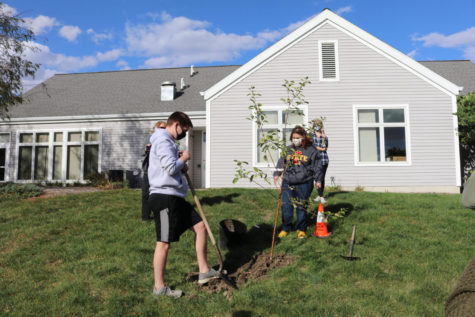#AskMeAmes: ‘What are some tips for checking my white cis male privilege?’
3D Character holding up male gender symbol.
April 11, 2019
A week ago we asked you ‘what do you want to know about sexual assault awareness/denim day?’ through our #AskMeAmes platform.
The question chosen by you was, “What are some tips for remaining cognizant of my white cis male privilege?”
To answer this question, we should understand the terminologies of cis and male privilege.
First and foremost, cis is the short abbreviation for the word, “cisgender.’’
According to an article done by Time Magazine in 2014, cisgender describes an individual who identifies themselves as the gender they are assigned to at birth.
The vast majority of people are considered cisgender and the word is considered to be an equal to the term transgender, which is the terminology used to describe someone who identifies themselves as a gender different from what they were assigned at birth.
As the term cisgender has grown in usage, so has the term ‘male privilege.’
To define the term ‘male privilege,’ said Michael Goebel, lecturer in sociology, the term is tricky.
Goebel said people should first understand the historical context of the United States and that the country was set up by a patriarchal structure.
“When we think about the idea of patriarchy, we are really thinking about how society has been structured to be male dominated, male oriented and male centered,” Goebel said.
Goebel also spoke of the idea of patriarchal dividend. The idea is because men shape society and shape it to be beneficial for men, other men are able to gain privilege or prosper through the advantage.
“The closer you are to the identity set that holds the most power, the more dividends you’re paid.” Goebel said.
For men to be aware and for change to occur, Goebel said he believes people need to be educated for change to be combated.
For guidelines that men can follow, we suggest the ‘10 tips men can do to prevent gender violence,’ which were adapted by educator and filmmaker Jackson Katz and released in 1999.
- The first tip Katz stated was for men to acknowledge gender violence as a men’s issue that involves men from backgrounds of all ages, races and socioeconomic statuses.
- Second is to not turn away from any abuse or disrespect women could be receiving from a man. Katz suggests that if comfortable, men should confront the abuser and urge the one abusing to seek professional help.
- The third set of advice given was to acknowledge any attitudes and actions that could perpetuate sexism and violence toward women and work toward a change.
- The fourth set of advice suggested by Katz is through asking to help a woman who is experiencing abuse.
- The fifth set of advice for individuals who have emotionally, sexually, physically or psychologically abusive toward women should seek professional help.
- The sixth set of advice is for men to be an ally to women who are working to end all forms of gender violence.
- The seventh set of advice for men is to recognize and speak out against homophobia and gay-bashing language.
- The eighth set of advice given by Katz is for men to attend programming, take classes, watch films, read books and articles about the ties to multiculturalism and masculinity, gender inequality and the root of gender violence.
- The ninth set of advice by Katz is for men to fund or support sexism through mass media such as magazines, video and film, website subscriptions and music.
- Lastly, advice by Katz is for men to mentor and teach younger generations of men to not be involved in action or language that degrades or abuses women.
“Pushing toward equality, egalitarianism, imparity, equity, all of those things is really really important and it starts by actually seeing other people as humans,” Goebel said.
















